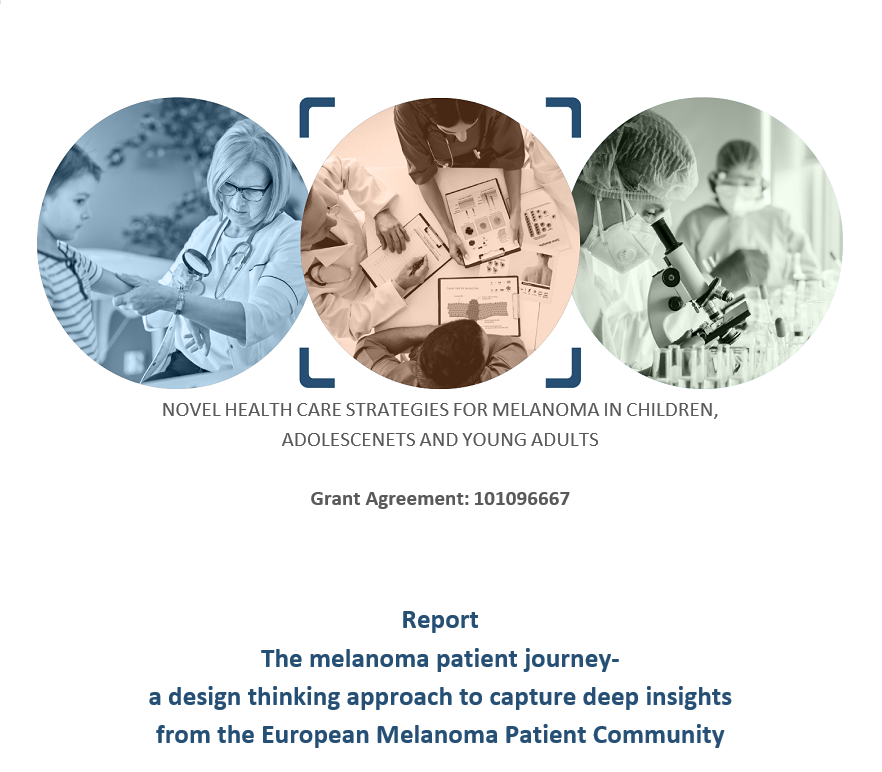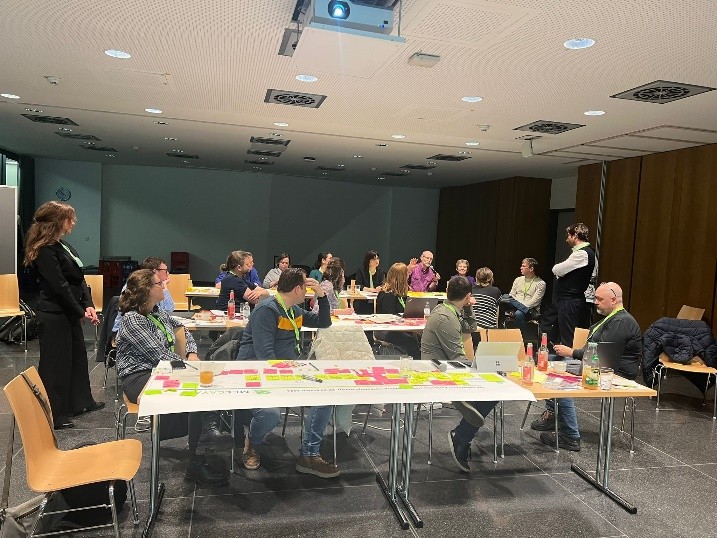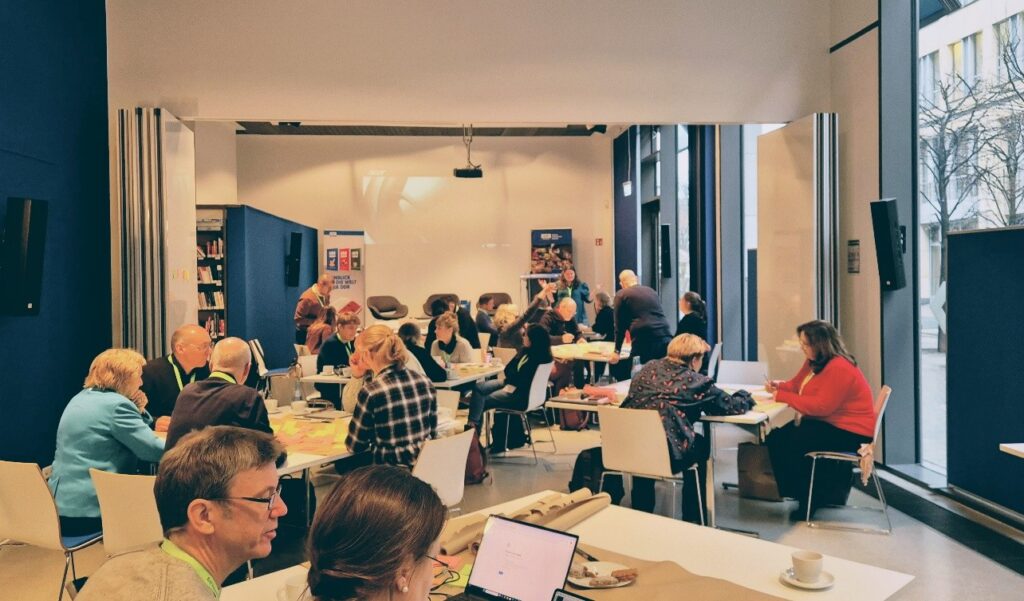
Insights from the MELCAYA Patient Journey Design Thinking Workshops
A report of European Melanoma Patient Community
Under Work Package 7, a critical milestone was reached through two collaborative Patient Design Thinking Workshops supported by European melanoma patient organisations. Held in Berlin on 22–24 March and 6 December 2024, the sessions brought together melanoma patients, caregivers, and advocates from 14 European countries to map the real-world experiences of melanoma patients. The workshops resulted in AMER’s internal report: “The Melanoma Patient Journey – A Design Thinking Approach to Capture Deep Insights from the European Melanoma Patient Community.” Its findings are now guiding the work of WP7 partners as they shape recommendations for future melanoma care models.
A Design Thinking approach
Building on the culture of patient forums where narratives and collaborative problem-solving are prominent, we have looked further into design thinking methods to capture patient insights in a structured way. Design thinking is an iterative, that focuses on a collaboration between designers and users to bring innovative ideas to life based on how real users think, feel and behave. The Patient Pathways Map, also known as the Patient Journey Map, preserves the natural expression and interactions seen in our online forums while offering a structured visual framework to gather diverse patient perspectives. We considered this approach has the potential to captures needs, unexpected insights, and opportunities for improved solutions. For both workshops, AMER used the MPNE Patient Journey template in both printed and digital versions, a design thinking tool created by MPNE we previously tested for uveal melanoma.

Figure 1. MPNE Patient Journey Template

Figure 2. Example of completed Patient Journey Map
MPNE Patient Journey map included six phases: Diagnosis, Primary Treatment and Follow-up, Surveillance, Metastatic Diagnosis and Treatment Planning, Metastatic Treatment and Follow-Up Care and End-of-Life Care. Patients were invited to describe touch points as ‘’the steps they took along (in blue). Pain points (in red) signalised the problems along the path, generally associated with steps or something that was broken in the journey. Maps included opportunities to describe the external actors (specialists, family, etc.) involved, emotions and proposed solutions.
Key Findings: A System Under Strain
During both workshops, patient echoed a shared reality: systemic, structural, and behavioural barriers persist throughout the melanoma care journey. Seven recurring themes emerged:
- lack of specialized expertise– knowledge in melanoma diagnosis and treatment unequally spread over countries
- delayed access– patients face bottlenecks in getting timely diagnoses and referrals to expert care
- research gaps– barriers to participating in clinical research remain high, limiting treatment options
- system fragmentation– poor coordination between institutions often leads to poor care
- negative behaviours and attitudes– paternalism and a defensive approach to medicine could undermine patient care
- psychosocial and financial burden– emotional distress, economic strain, and inadequate palliative support were commonly pointed out in both western and eastern European countries
- value of patient agency– involvement in decision-making likely led to better outcomes, along a sense of regaining control and dignity
Recommendations for Change
From these insights, patients and advocates proposed several recommendations:
- support education of healthcare professionals across Europe in melanoma sub-specialties, including paediatric melanoma, a rare condition.
- enable cross-border access to specialized centers for treatment options.
- accelerate research implementation and expand fair access to clinical trials.
- create standardized care pathways, especially for high-risk melanoma groups and children.
- promote patient agency and shared decision-making, moving away from paternalistic models.
- design psychosocial and financial measures aligned with real patient needs.
- enable patients’ engagement in both care and research processes.
When it comes to childhood melanoma, the gaps seemed wider. Families asked opportunities for research and equitable access to precision oncology, genetic testing, and personalised treatments for children.
To close these gaps, the report calls for closer collaboration between adult and pediatric melanoma centers, along with urgent development of pediatric-specific care pathways and research programs.
Our group largely comprised highly proactive patients and advocates familiar with how the system operates. Such participants may have interrogated institutional processes and held higher expectations. In contrast, less knowledgeable or marginalized groups may encounter different challenges or be unable to access the system at all.
A Pan-European Perspective
With contributions from patient organisations across Cyprus, Denmark, Finland, France, Germany, Hungary, Ireland, Latvia, the Netherlands, Poland, Romania, Spain, Sweden, and the UK, the report reflects a truly European snapshot of melanoma care. While the health systems vary, the pain points are strikingly similar—and so is the call to action.
The full report – including insights from all groups, such as the Congenital Melanocytic Nevi (CMN), Childhood Melanoma (CHM), Young Adults, Adults and Advanced Melanoma – can be accessed on AMER website: https://www.melanomromania.org/_files/ugd/d01547_7313741622b54d9b801ec3e9f4b0c38e.pdf

Figure 3. Building CAYA Melanoma Patient Journey Maps and group debate Berlin 22-24 March 2024

Figure 4. Reiteration of Melanoma Patient Journey Maps at MPNEhubs meeting, Berlin, 6th December, 2024
#PatientJourney #DesignThinking #ChildhoodCancer #StakeholderEngagement #InnovationWorkshops

